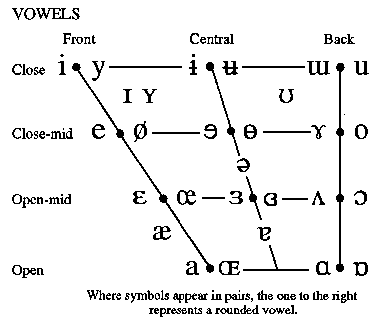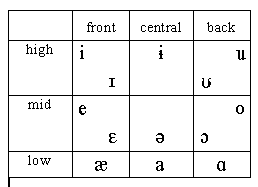 The IPA chart uses the terms open and close instead of low and high.
The IPA chart uses the terms open and close instead of low and high.


 The IPA chart uses the terms open and close instead of low and high.
The IPA chart uses the terms open and close instead of low and high.
 The IPA chart has four height levels instead of three. The mid level
in the tic-tac-chart is split into two levels in the IPA chart:
The IPA chart has four height levels instead of three. The mid level
in the tic-tac-chart is split into two levels in the IPA chart:
[ ] and
[
] and
[ ] are demoted
to second-class citizens (non-cardinal vowels) and pushed to the inside of the chart.
This makes the implicit claim that the difference between [e] and
[
] are demoted
to second-class citizens (non-cardinal vowels) and pushed to the inside of the chart.
This makes the implicit claim that the difference between [e] and
[ ] is mainly
one of height, not of some extra "tenseness" property.
] is mainly
one of height, not of some extra "tenseness" property.
 ] is not
parallel to the acoustic difference between [i] and
[
] is not
parallel to the acoustic difference between [i] and
[ ].
].
 ]
and for [e] and [
]
and for [e] and [ ],
as suggested by the tic-tac-toe chart, and the tense/lax distinction is
made primarily by moving the tongue root forward or backward in the
pharyngeal cavity. (See the section of the textbook on Advanced Tongue Root.)
],
as suggested by the tic-tac-toe chart, and the tense/lax distinction is
made primarily by moving the tongue root forward or backward in the
pharyngeal cavity. (See the section of the textbook on Advanced Tongue Root.)
 [a] is a front vowel in the IPA chart and central in the tic-tac-toe chart.
In the IPA chart, [æ] is a second-class citizen squeezed in
between [a] and [
[a] is a front vowel in the IPA chart and central in the tic-tac-toe chart.
In the IPA chart, [æ] is a second-class citizen squeezed in
between [a] and [ ].
].
 The IPA chart treats [
The IPA chart treats [ ]
as an unrounded back vowel. The tic-tac-toe chart treats it as a central
vowel.
]
as an unrounded back vowel. The tic-tac-toe chart treats it as a central
vowel.
As suggested by the layout of the IPA chart, back unrounded
vowels will tend to be somewhat more central than rounded
ones, both acoustically and articulatorily. But English
[ ] is clearly
central, more so that we can explain away like this.
] is clearly
central, more so that we can explain away like this.
Unlike the earlier differences, this is a case of using the same
symbol for two different sounds. From the viewpoint of strict
standardization, English linguists are just plain wrong to use
[ ] for the
vowel of cup. Especially in narrow transcriptions, it would
be more accurate to add a diacritic indicating that the vowel is
advanced or centralized, or to use the symbol
[
] for the
vowel of cup. Especially in narrow transcriptions, it would
be more accurate to add a diacritic indicating that the vowel is
advanced or centralized, or to use the symbol
[ ] for a
lower-mid central vowel (approved in 1996). From a more realistic
viewpoint, English linguists are simply following the IPA-sanctioned
practice for broad transcriptions of using the symbol for the
nearest cardinal vowel whenever practical. (If we were writing a
grammar of English, we'd have a moral obligation to put in a
footnote explaining how our broad use of
[
] for a
lower-mid central vowel (approved in 1996). From a more realistic
viewpoint, English linguists are simply following the IPA-sanctioned
practice for broad transcriptions of using the symbol for the
nearest cardinal vowel whenever practical. (If we were writing a
grammar of English, we'd have a moral obligation to put in a
footnote explaining how our broad use of
[ ] differs
from the standard for cardinal vowel 12.)
] differs
from the standard for cardinal vowel 12.)
 In the tic-tac-toe chart, the mid-central region is a box like any other.
In the version of the IPA chart printed in the textbook, um, well, it's
anybody's guess what's going on there.
In the tic-tac-toe chart, the mid-central region is a box like any other.
In the version of the IPA chart printed in the textbook, um, well, it's
anybody's guess what's going on there.
The cardinal vowel system hinges on the four corners of the vowel space, and the cardinal vowels are arranged around the well-defined edges. The IPA has tended to look at the central region as a nebulous no-man's-land -- that area of the chart might as well have had a "Here there be dragons" sign. In 1996, the IPA bit the bullet and designated symbols for rounded and unrounded central vowels at each of its four height levels (except low). Schwa is used as a cover symbol for any unrounded mid central vowel when you don't want to get fussy over whether it's higher-mid or lower-mid, tense or lax. This is now way more central vowel symbols than we'll ever need. But at least it's consistent.
The textbook still has the old chart. The revised chart is above.